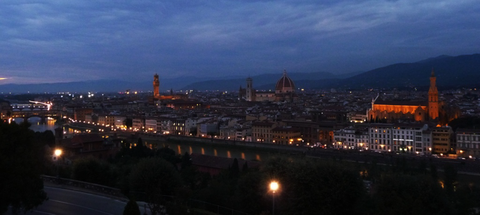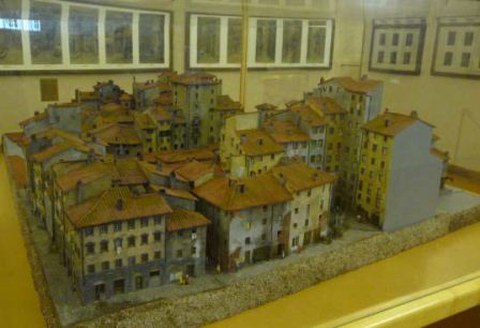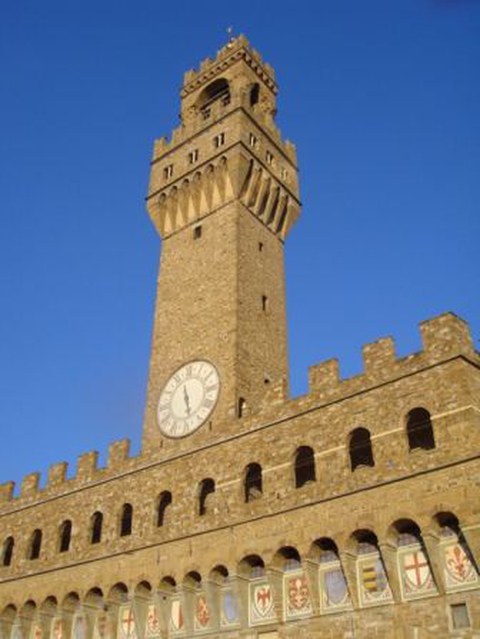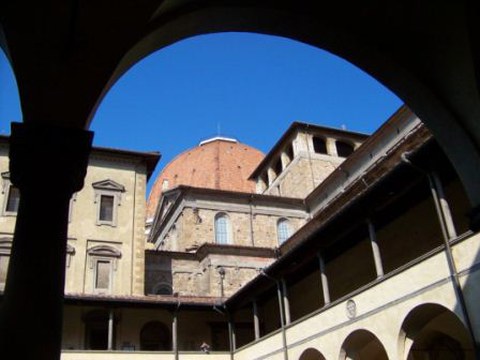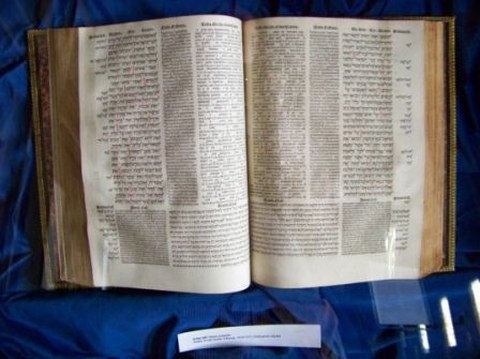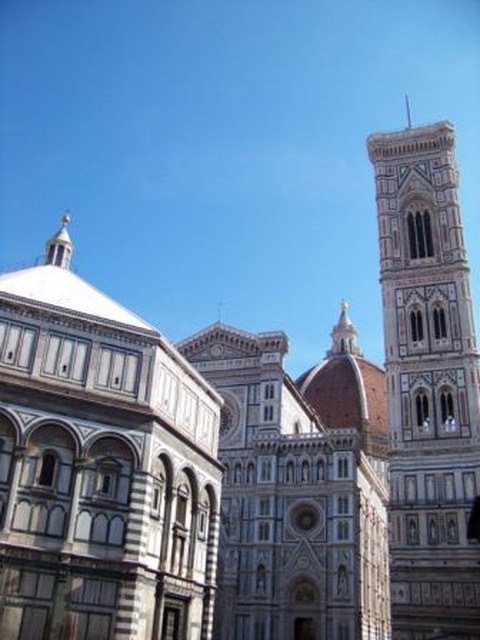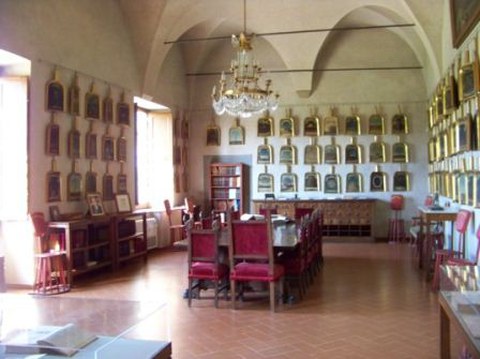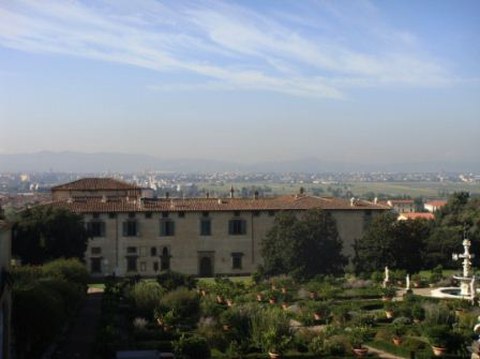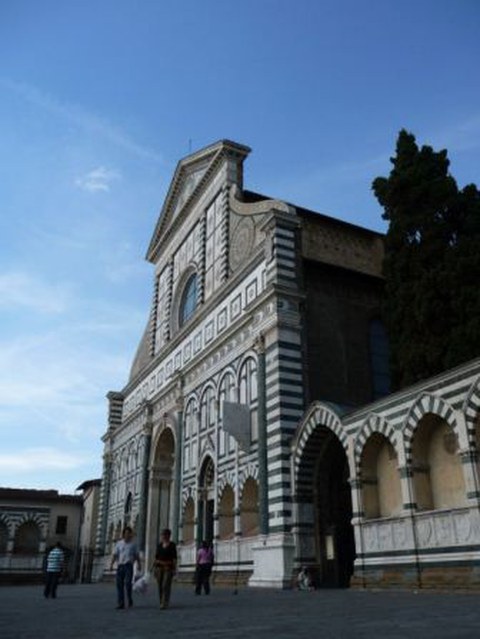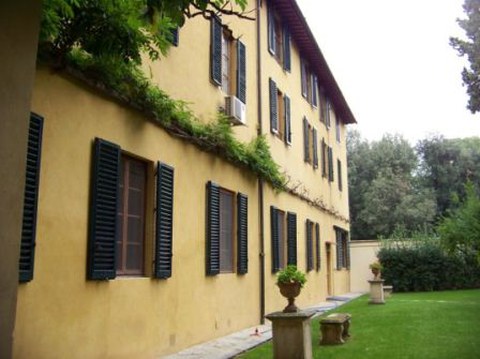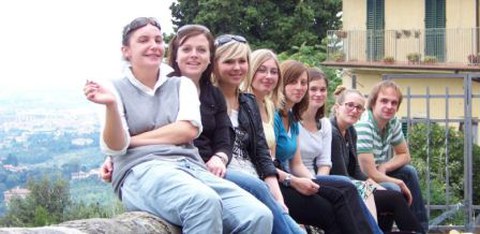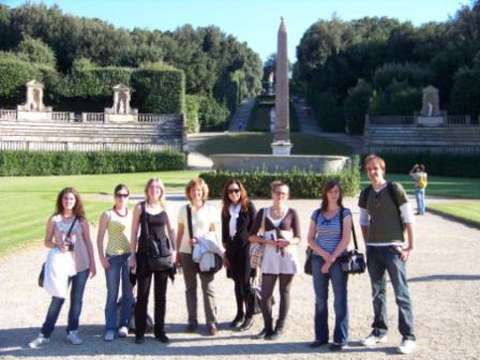Excursion Florence 2010
VIAGGIO DI STUDI - EXCURSION TO FLORENCE
SEPTEMBER 27, 2010 TO OCTOBER 4, 2010
The Italian lecturer at the Institute of Romance Studies, Signora Bellini, gave her students the opportunity to take a closer look at her home city of Florence.
- Interview Cristina Giachi (Italiano)
- Newsletter Dresden International (October 2010)
- Dresden University Journal (2010/17)
- Dresden University Journal (2010/19)
MONDAY, SEPTEMBER 27, 2010
On September 27, 2010, the plane took off for Florence. On board: Signora dott.jur. Simona Bellini, M.A., Prof. Maria Lieber (Chair of French/Italian Linguistics) and nine students of Italian Studies at TU Dresden. A varied and interesting program awaited them in Florence, with historical and art-historical destinations as well as scientific institutions on the agenda.
TUESDAY, SEPTEMBER 28, 2010
The Museo di Firenze com'era (Museum of Florence as it once was) provided a successful introduction, offering an insight into the historical development of the city from antiquity to the 19th century using maps, sketches and models. The magnificent Cappelle medicee and the Palazzo Medici-Riccardi were then visited.
The students were well prepared for the interview with Christina Giachi, City Councillor for University, Research and Youth Policy. She received the excursion group in the Palazzo Vecchio, the magnificent town hall of the city of Florence, and persistently answered all of the students' questions, which they had formulated based on their areas of expertise. After the interview, the students had the opportunity to visit the historic building, the Salone dei Cinquecento (Hall of the Five Hundred) and a secret passage leading to the "spy window" above the hall.
The first day ended with a stroll along the lively Ponte Vecchio and a short visit to the Chiesa di Santa Felicità.
WEDNESDAY, SEPTEMBER 29, 2010
The second day was to take us to Florence Cathedral Square in various stages. We started at the Santa Monaca youth hostel, located on the left bank of the Arno, known as Oltrarno in Florence. From there we crossed the Ponte a Santa Trinita, which owes its fame above all to the flat arch construction, which was very new in Renaissance times. After being blown up by German occupying troops in 1944, it was reconstructed in 1958 according to old sketches. A few meters further on, we were drawn to the Chiesa di S. Trinita, whose simple beauty delighted all participants. The keeper of the keys was at work and so we were lucky enough to be able to take a reverent look inside the sacristy. We then visited the Chiesa di San Lorenzo, one of the oldest and largest churches in Florence. It was consecrated in 393 and it was Brunelleschi who drew up the plans for the reconstruction and renovation of the church in the Quattrocento. He also designed the monastery complex adjoining the Chiesa di San Lorenzo and its cloisters, which still house the Biblioteca Medicea Laurenziana today.
Next destination: Il Duomo. Having already seen the cathedral and the impressive dome painting - started by Vasari and finished by Zuccari - from the inside the day before, today we could choose between the cupola or the campanile, from both vantage points we were rewarded after a long climb with a wonderful view over the city in bright sunshine.
For lunch, Signora Bellini gave us an insider tip: the Biblioteca delle Oblate. This is where the city's young people meet, study in the library, eat in the small cafeteria or simply enjoy the wonderful view of the dome of Florence Cathedral.
In the afternoon, our patience was put to the test in the queue in front of the Uffizi, but as it turned out, it was worth it.
THURSDAY, SEPTEMBER 30, 2010
Thursday began with a bus ride across Florence to the Accademia della Crusca, located just outside the city. This makes the heart of every Italianist beat faster. For 400 years now, it has been dedicated to the developments and trends of the Italian language. The academy published the first dictionary of the Italian language in 1612. Reason enough to listen to a detailed lecture. The history of the Academy is closely interwoven with the history of the Italian language and the recurring language debate, the Questione della Lingua. Every student was reminded of the introductory course in linguistics and was able to refresh and test their knowledge. In addition to the Academy, the students were able to visit the park adjoining the building and enjoy an excellent view.
In the afternoon, we were supposed to visit the Chiesa di Santa Maria Novella with its impressive façade designed by Leon Battista Alberti, but they wouldn't let us in: as there were more than ten of us (eleven in fact), we would have had to register as a group. However, the trip was not to be in vain, and so the Italian studies students were given an insight into the Italian temperament. In the end, we were all able to visit the church, so 1:0 for Signora Bellini. After visiting the church and cloister, the last point on the agenda was the Battistero on the cathedral square. The silence there, in the middle of the hustle and bustle of Florence, offered a moment of peace and relaxation for everyone involved.
In the evening, most of the students decided to climb up to Piazza di Michelangelo. Situated above the city, this lively square is an ideal vantage point over the entire city and offers a spectacular view of it at sunset.
FRIDAY, OCTOBER 1, 2010
Friday began with another excursion into science. The Institute of Art History and Casa Zuccari were visited with a detailed and informative guided tour. In addition to the numerous projects, the excursion to the 3D library was particularly spectacular. Some of them started dreaming about what it would be like to study here in these historic buildings and in Florence with a scholarship. After a caffè at Scudieri and a little book shopping at Feltrinelli, we paid our respects to a very special gentleman, Michelangelo's David in the Galleria dell'Accademia. Long discussions about the proportions and delicacy of this man took place not only among the students, but also the numerous visitors around the David exchanged their opinions with large and small gestures. The day ended with a first summary of the excursion in a relaxed atmosphere and a visit to the Piazza della Santissima Annunziata and its church.
SATURDAY, OCTOBER 2, 2010
The last day of the program - Saturday - began with a visit to the medieval, multi-storey, restored Palazzo Davanzati in the heart of Florence. Here we were able to gain an insight into the living conditions of the Middle Ages, rooms, utensils and architectural considerations, such as how fire protection was designed at this time, why the kitchen is on the top floor, what belongs to the furnishings of a bedroom and what traps such a building needs to protect itself from enemies. Afterwards we visited the Palazzo Pitti, a huge building complex with the large Giardino di Boboli. From here, too, we were able to enjoy a wonderful view of the city and so we didn't make our way back to the ostello, the youth hostel, until sunset.
SUNDAY, OCTOBER 3, 2010
Sunday - the last day of our excursion - remained free. And so we visited a few more sights in Florence, such as the Basilica di Santa Croce, or we did as the Florentines did and drove up to Fiesole, the foundation of which dates back to the Etruscan era and at the foot of which the city of Florence was later founded. Fiesole is a peaceful place surrounded by trees and olive groves. We wandered from one slope to the other of the ancient town and always found beautiful places to linger. Unfortunately, we were only able to admire the teatro romano from the outside, as our financial reserves were running low and tickets still had to be written and presents bought.
MONDAY, OCTOBER 4, 2010
Unfortunately, the flight back to Dresden left on Monday. After a stopover in Munich, the second landing in Dresden was somewhat turbulent due to the gusts of wind, but we landed: Signora dott.jur. Simona Bellini, M.A., Prof. Maria Lieber and nine students of Italian Studies at TU Dresden.
During the excursion, students prepared short presentations on individual historical aspects and personalities. The accommodation was a hostel that used to be a monastery; many corridors and confusing signposts made going to the shared bathroom an exciting affair at first!
We would like to take this opportunity to once again thank Signora Bellini, who painstakingly put together a wonderfully varied and informative program and ensured that everything ran smoothly. We would also like to thank Prof. Lieber, the City of Dresden, the Society of Friends and Sponsors of TU Dresden e. V. and the Faculty of Linguistics, Literature and Cultural Studies at TU Dresden.

